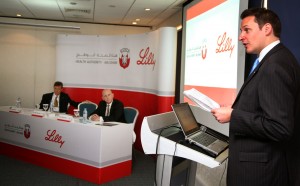- HAAD outcomes research presented at IDF’s WDC; findings contribute to understanding of diabetes burden in the Emirate
- Threefold increase in cost for diabetes patients with complications over diabetic patients without complication; prevalence of diabetes in Abu Dhabi second highest globally
The Health Authority of Abu Dhabi (HAAD) today announced the results from its initial research collaboration with Lilly, launched one year ago. The research focused on understanding the burden and costs of diabetes and cardiovascular disease in the Emirate of Abu Dhabi, with specific analyses on complications, treatment patterns, patient outcomes and projected risk. The resulting data is being shared with regional and global experts in the treatment of diabetes at the International Diabetes Federation’s World Diabetes Congress (WDC) currently taking place in Dubai (December 4 – 8, 2011).
 Dr Oliver Harrison – Director of Public Health and Policy at HAAD, explained the importance of the research and its outcomes. “Diabetes is a growing global epidemic and cost burden. The Emirate of Abu Dhabi ranks second highest in the world in terms of diabetes prevalence, and that is among a young population. In our aim to understand the cost burden of diabetes and its complications in Abu Dhabi, the research has revealed a number of findings which will help us to shape public health policy. For example, we found a threefold increase in annual treatment costs for patients with complications relating to diabetes as compared to diabetes patients without complications. This data suggests that programs, procedures or medical solutions that can help prevent or delay complications in diabetic patients might not only be cost-effective, but more importantly could help to increase patients’ quality of life, and potentially reduce the number of diabetes related deaths in the Emirate”.
Dr Oliver Harrison – Director of Public Health and Policy at HAAD, explained the importance of the research and its outcomes. “Diabetes is a growing global epidemic and cost burden. The Emirate of Abu Dhabi ranks second highest in the world in terms of diabetes prevalence, and that is among a young population. In our aim to understand the cost burden of diabetes and its complications in Abu Dhabi, the research has revealed a number of findings which will help us to shape public health policy. For example, we found a threefold increase in annual treatment costs for patients with complications relating to diabetes as compared to diabetes patients without complications. This data suggests that programs, procedures or medical solutions that can help prevent or delay complications in diabetic patients might not only be cost-effective, but more importantly could help to increase patients’ quality of life, and potentially reduce the number of diabetes related deaths in the Emirate”.
The research, which combined the expertise of HAAD in population-based data collection and screening programs with Lilly’s data analysis and interpretations capabilities, also provided insights into the treatment of cardiovascular disease, particularly among diabetes patients. In one study comparing the experience of patients in Abu Dhabi with those suffering from similar medical problems in the United States, data indicated a need for more aggressive treatment with anti-hypertensive medication to help regulate blood pressure in diabetes patients, a finding which supports international guidelines.
A separate study, titled A potential cardiometabolic time-bomb? also examined cardio vascular disease (CVD) and increased risk among Emirati nationals in Abu Dhabi. The findings raised a red flag for the Emirate’s future healthcare needs, noting an excessive potential burden on women which is set to increase as Abu Dhabi’s population ages. The study’s authors noted that these initial findings warrant paying specific attention to women and future CVD risk.
“Public health program planning should be guided by evidence generated from a careful analysis of good data. That data can be used to identify key patients that may be at increased risk of adverse health outcomes and allow HAAD to design interventions and management programs to appropriately address those needs,” explained Steven Babineaux- senior research scientist – global health outcomes division at Lilly. “We are proud to have collaborated with the considerable talent at HAAD on the five studies presented at the World Diabetes Congress, and look forward to future research to inform data-driven policy decisions.”
Joachim Becker – senior advisor – Lilly Diabetes strategy for Emerging Markets – explained the objective of Lilly’s collaboration with health authorities, “Lilly aims to develop meaningful and tailored collaborations, with projects based on identified partner’s needs, and solutions drawn from the strengths of all partnered organizations, with the common objective of controlling the progression of diabetes. With every project, Lilly wants to support the creation of self-sustaining, best practice models that encourage replication beyond project geographic borders.”




































